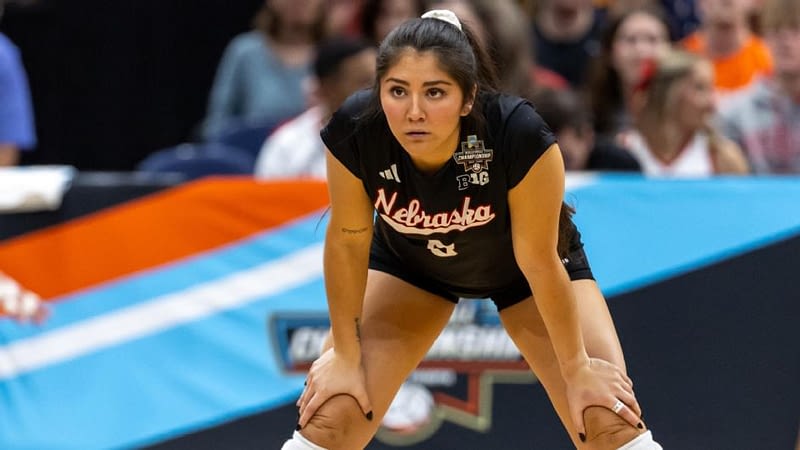The Unsung Heroes: Liberos in NCAA Volleyball
Picture this: a sea of red and white jerseys, each player poised and ready for action. But amidst this vibrant display, one figure stands out, clad in all black. That’s Lexi Rodriguez, Nebraska’s 5-foot-5 libero, a defensive dynamo whose presence on the court is as commanding as it is crucial.
Directly across the net, towering at 6-foot-9, is Wisconsin’s right-side hitter Anna Smrek. With a lineage that includes a two-time NBA champion, Smrek is a formidable opponent, capable of reaching heights over 11 feet when she leaps. The net, standing at 7 feet, 4 1/8 inches, seems almost trivial in comparison.
Beside Smrek is CC Crawford, Wisconsin’s middle blocker. At 6-foot-3, she comes from a family of athletes: a father who ran Division I track, a mother who played Division I basketball, and a brother who is a defensive lineman at Iowa. Blocking is in her blood.
As the match unfolds, Wisconsin finds itself down by a set and trailing 5-2. The urgency for points is palpable, and Rodriguez is acutely aware of the challenge. She knows the Wisconsin hitters will be relentless, swinging with power and precision, aiming to send the volleyball crashing onto Nebraska’s side of the net. Her mission? To prevent that from happening.
Merritt Beason steps back to serve. Rodriguez, ever vigilant, guards the sideline as Smrek rises for a swing. The Nebraska block deflects the ball back to Beason, and a rapid exchange ensues. Crawford tips the ball gently over the Nebraska block, aiming for the front corner. Rodriguez reacts with lightning speed, diving and extending her left arm to pop the ball up just before it touches the court. She slides into the referee stand but quickly regains her footing, ready for the next play.
Smrek tries again, this time targeting a vacant spot on the Nebraska court. But Rodriguez, undeterred, slides on her knees to make the dig. She rises and backpedals, maintaining her defensive stance.
Smrek isn’t done yet. She approaches with determination, slamming the ball toward the back of the court. Rodriguez stretches her arms to the right, falling as she deflects the ball back to Wisconsin’s side. She rolls over, springs to her feet, and watches as her teammate, middle blocker Andi Jackson, pushes the ball to Wisconsin’s side. Point Nebraska.
Rodriguez celebrates with a slap to the floor and a triumphant fist pump before joining her teammates in a huddle. In a rally lasting 44 seconds, she played the ball five times. Mission accomplished.
Justine Wong-Orantes, an Olympic gold medalist and former Nebraska libero, praises Rodriguez’s impact: “Lexi takes up so much of her side of the court. You see her flying around, creating longer rallies and tiring out opponents because you feel like you cannot score on a libero like Lexi.”
Rodriguez is part of a new wave of liberos in NCAA volleyball, transforming the game since their introduction in 2002. These back-row defensive specialists, distinguishable by their different colored jerseys, are not allowed to attack above the net or block. Yet, they inject excitement into the game, extending rallies, stymieing hitters, and providing their teammates with scoring opportunities. Their blend of athleticism and anticipation keeps the ball from hitting the floor.
Wong-Orantes continues, “Lexi is always in the right place. You see a lot of defensive players who are a little flashy and out of position, then make a spectacular play. But Lexi is always just in the right spot, so she doesn’t need to make a tremendous dig. Her ability to read the game is elite.”
Rodriguez is one of four finalists for the AVCA national player of the year and could become the first libero to win the award. She’s also just eight digs away from tying Wong-Orantes’ Nebraska record of 1,890. While she makes it look effortless, being a libero requires immense talent and courage.
Wong-Orantes recalls a challenging game against Wisconsin during her freshman year. The Badgers targeted her with every serve, some hitting her shoulders, others her chest, and some ricocheting off her arms. To protect her, coach John Cook moved her out of the serve receive position, hiding her behind the hitters.
“That was the most demoralizing feeling,” Wong-Orantes admits. “As a libero, you’re supposed to be good at passing, and being hidden in the formation was shameful. It was tough to break out of that.”
The position is not for the faint-hearted. Liberos at the final four have their own harrowing tales to share.
-
Louisville’s Elena Scott, an AVCA first-team All-American, describes the physical toll: “It’s commonplace to get hit in the chest or even the throat during practice. It kind of knocks the wind out of you.”
-
Scott recounts a recent incident from the Cardinals’ second-round win over Northern Iowa. Trailing 2-1 in the fourth set, she dove for a ball, colliding with teammate Charitie Luper. The impact left her with a sharp pain in her lower back, an old injury flaring up. Despite the pain, she played on, finishing with a season-high 26 digs.
-
Pitt libero Emmy Klika shares a similar experience. During a match against Pepperdine, she dove for a ball and collided with teammate Valeria Vazquez Gomez, hearing her neck crack as she landed. “I was on the ground thinking, ‘What did I just do to myself?'” Klika recalls. Fortunately, she was fine, but the fear lingered.
-
Penn State junior libero Gillian Grimes remembers a club tournament in Indianapolis. Facing a powerful Texas team, she took a hit to the face from an outside hitter. “That definitely hurt,” she says. “I thought I was concussed, but you just keep playing.”
Even Rodriguez admits that fear is part of the libero life. “There are always times when there’s an open net and a big hitter,” she says. “Those are always the scariest.”
Originally Written by: Aishwarya Kumar





















